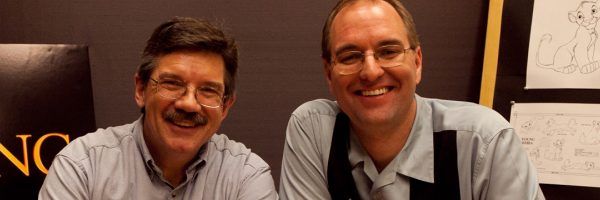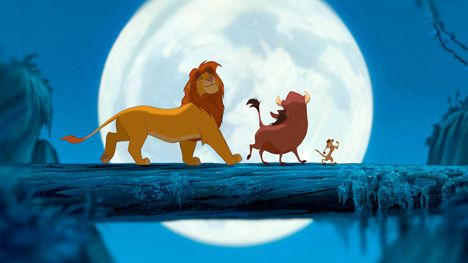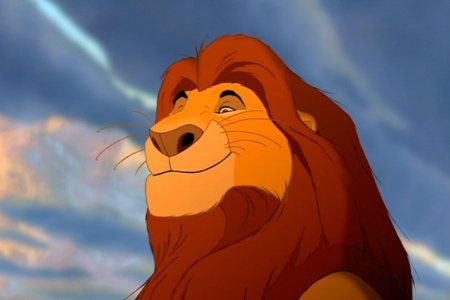Mark Henn (“Young Simba”) and Tony Bancroft (“Pumbaa”) were two of the supervising animators on The Lion King, when the film was originally produced in the ‘90s. With an unforgettable story and breathtaking animation, the now beloved characters are returning to the big screen, for the first time ever in 3D. This new format immerses viewers in these epic settings, in such a way that they’ve never been able to before, and invites new generations to experience the “Circle of Life.”
At a press day held at the Walt Disney Animation Research Library (ARL), animators Mark Henn and Tony Bancroft spoke to Collider for this exclusive interview about how they each ended up on their career paths, how they came to be responsible for their respective characters, the most complicated thing to animate at the time, what it’s like to see these characters brought to life in 3D, and how things have changed since they originally made the film. Check out what they had to say after the jump:
Question: How did you guys become animators? Was it just something you had always wanted to do?
TONY BANCROFT: I was socially inept and geeky.
MARK HENN: He wanted to get the girls and thought this was a good way.
BANCROFT: I wasn’t a jock, so I thought that, if I drew funny pictures, the girls might like me more.
HENN: No, pure and simple, it’s been a boyhood dream for me, and for a lot of us. For me, it was definitely something that I grew up wanting to be.
Did you just have an inborn talent for it, or did you spend a lot of time honing your craft?
HENN: Yes and no. I drew all the time, as a small boy. I loved going to Disney films and loved seeing Disney animation. So, every time I could get a chance to grab a piece of paper and draw, I did, at times that I probably shouldn’t have been drawing. I always enjoyed that. As far as learning about animation, that was just a maturing. As I got older, I learned more about animation and exactly what’s involved and who did it. I didn’t know a whole lot, but you learn as you grow. For me, it’s a boyhood dream come true.
BANCROFT: My dream was just to be Mark Henn when I got older. I idolized him.
HENN: Oh, you poor thing.
BANCROFT: He was my mentor, for many years. I look up to him.
How did you end up at Walt Disney Animation Studios, and how were you able to grow as artists, once you were there?
HENN: I grew up in Ohio, and this was what I had aspired to do. I ended up coming to California and attending the California Institute of the Arts (CalArts). The Disney character animation program, at that time, was only four years old, so I was in the fourth year of that program. Most of the teachers of the first generation of that program were all retired Disney artists, so we learned from the very best. For two years at school, I was sitting at the feet of some of the best artists that the studio had to offer. What happened was that each year, the studio would come up and review student work and the student films. The goal, at that point – and this was in the early ‘80s – was to get hired by Disney. Disney was about the only game in town, at that point. So, I was hired after my second year in the program, and I’ve been here for 31 years now.
BANCROFT: I had a similar route. I grew up drawing, all the time, when I was a kid. I started out doing comic strips. I just fell in love with Charles Schultz and drew Snoopy. That just led to Disney animation, and I found out about CalArts. I went many years after Mark, but it was from there that I got hired directly into an internship for Disney, around the time of The Little Mermaid. Mark and I started at the Disney MGM Studios in Florida together. I worked under Mark, for several years, doing clean-up and learning from him, as my mentor. It was Mark that really taught me a lot about the discipline of animation, how to animate with passion, and put your whole self into your scenes and work. That’s why I credit Mark with being my mentor and teaching me a lot, when I was young.
How did you become responsible for your characters in The Lion King?
BANCROFT: It’s funny because The Lion King was happening at a time at the studio when they wanted to get more productive, and they were going to work on two films at the same time. That meant an opportunity for guys like me – the younger generation – to move up to supervising a character. It had never been done before, where they were working on two films, at the same time. Pocahontas and The Lion King were being done at the exact same time, and a lot of the more mature, experienced animators went on to Pocahontas, except for people like Andreas Deja and Mark Henn, who stayed behind. They had to really hire a brand new crop of animators for The Lion King, which was great for me. I loved that. I applied by sending in a videotape of all my scenes that I had done on the recent films at Disney. I had just come off of Aladdin, animating the character of Iago, and thought that maybe I could get a shot at animating another talking bird character, so I tried out for Zazu. And, the directors saw something more in me than even I saw, and gave me the character Pumbaa, which was a bigger opportunity than I had ever expected. It was one of the best days of my life, when I found out that I had gotten the character of Pumbaa. I was just so excited and scared, at the same time. The great thing about it was that that was the feeling that a lot of us had. Unlike Mark Henn, who had experienced supervising a character, many times before, so many of us were new that it made it acceptable and okay to feel like we were doing some new, for the first time. It felt like a college dorm atmosphere, a lot of the time. We were just joking and laughing and having a good time, making something that we were passionate about, and that we probably would have paid them to do. We enjoyed it so much. Don’t tell them that now, of course. But, it was a special and unique time, and I think the film really resonates because of it.
HENN: I was an old hat at this, by that time. We were getting started on Aladdin and, right after I finished my work on The Little Mermaid, I went down with a group of artists to be the nucleus of the studio in Florida, in 1989, so I had already been there for several years. I was on a trip back out here when we were developing Aladdin, and The Lion King was already in early development. I was actually really interested in doing Scar. I had talked to the producer, Don Hahn, about it and shared my ideas, but he, with his very quiet diplomatic wisdom, steered me away from that and told me that, while they felt very confident that I could have done Scar and done him quite well, they had other people that could do Scar. But, what was really key in his mind – and I had to take him at his word – was Simba. He told me, “If Simba doesn’t work, then the film doesn’t work. Simba is the key.” How do you say no to that? So, I was happy to take that role on. It was something different than doing a leading lady, and I had done two or three in a row, at that point, so having that break was a nice change of pace. It just all fell in. You had the great work of Jonathan Taylor Thomas, who did the voice. It was a group of primarily newly formed animators and supervisors that were given opportunities because the studio had split into two productions. Andreas [Deja] and I were probably the senior most on the crew, having had that experience, prior to that. It was great. I tend to gravitate toward the leading characters that have the greatest journey to travel and the greatest emotional swing in the movie. It’s subtle. They’re not always the funniest characters, getting the big laughs, but they’re important and you have to have them. Those are the kind of characters that I find very appealing, and Don [Hahn] knew that ‘cause I had worked with him before on a couple other movies, so I think he made the right choice.
At the time, what was the most complicated thing for you guys to animate?
HENN: Purely from a technical challenge, animation animals was a challenge. It always is. We spent many months with real animals, in the studio and in zoos. We had experts in. We had times of just sitting and drawing. We actually got to put our hands on some lions. We had cubs in Florida that came in. This was kind of like Bambi, for us. We wanted to get the same unique characters and charm, but they needed to be based on the reality of what makes these animals who they are. What makes a lion, a lion? What makes a warthog, a warthog? That’s always a real challenge.
What’s it like to see these characters brought into 3D now?
HENN: It’s kind of a completion. Had we had this technology back then, we probably would have originally done it in stereo and 3D. Now, that wildebeest stampede makes you feel like you are stampeded. You are right there, in the middle of it, with Simba. It was amazing then, and it’s even more so now. It takes what’s there and just takes it to a new level.
How has animation changed for you since The Lion King? How is what you do now different from how you approached things then?
BANCROFT: It’s not very different. Traditional 2D, hand-drawn animation, like we did in The Lion King, hasn’t changed that much. The technology helps from the standpoint of the final elements of color, ink and paint, and things like that, but the essence of one drawing on top of another, that creates emotion, character and life, is really the bread and butter of what we still do, nowadays. It’s still 24 drawings in a second, just like it was back then. It doesn’t get any easier, and it doesn’t get much harder. But, it’s the passion that you carry with you. What drives Mark and I is the love of drawing, the love of creating great characters, and working on these timeless movies, and none of that has changed. For us, it’s not too different.
HENN: The heart of the animator doesn’t change, and shouldn’t change. It’s just that some of the tools around him or her have evolved. As far as drawing, we don’t send our scenes out to camera anymore. They’re scanned in and digitized. And, we see things on a computer screen instead of a video screen, when we used to shoot video tests. For all of those peripheral things, technology has helped with or made our lives a little easier and more convenient. But, for a hand-drawn artist, it’s still a piece of paper and a pencil and the artist, and that relationship. The drawing is the acting. Even in CG, the principles are the same. It’s just that the means to the end are a little different. It’s a different tool, but you want the same results. You still want to come up with characters that are unique, and that audiences can identify with and remember, as a character. It’s cool.



